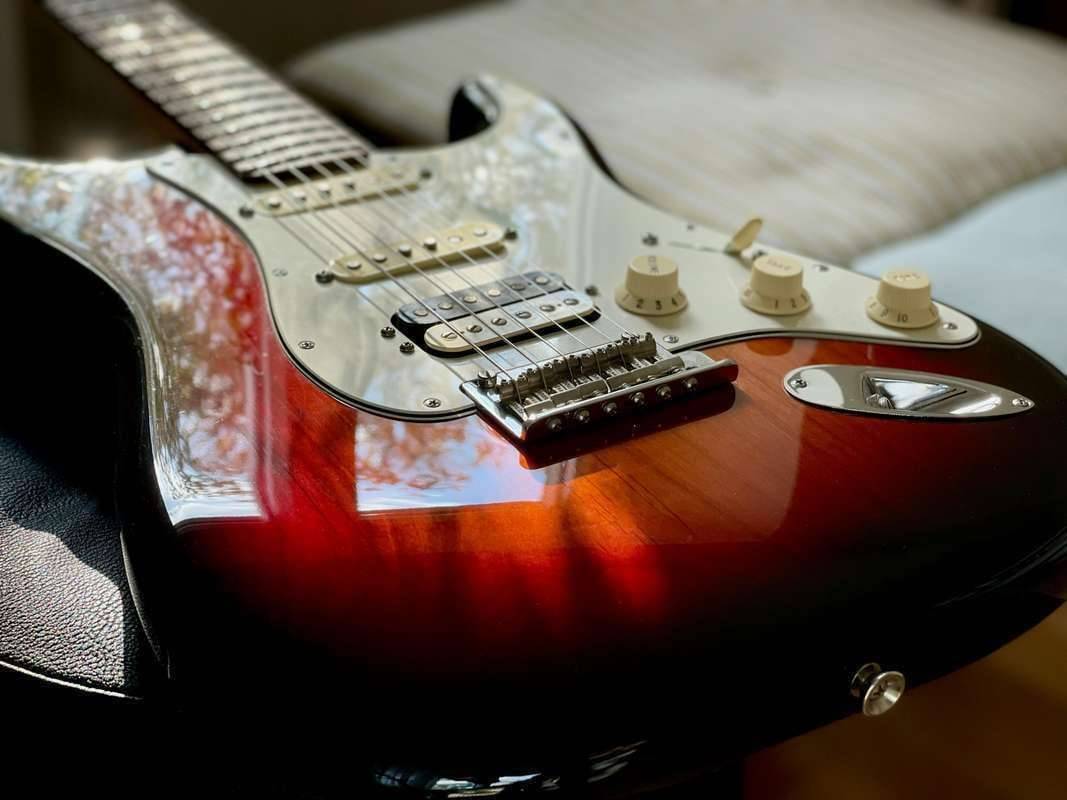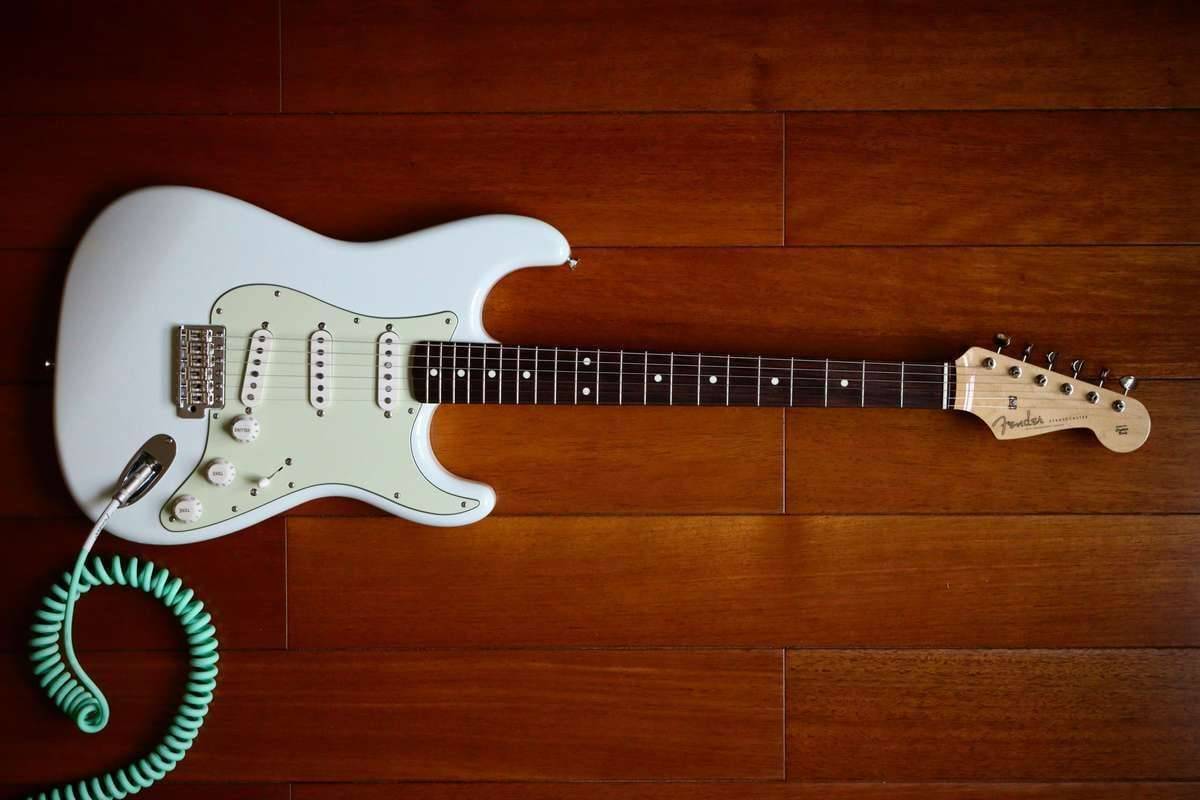Stratocaster Tremolo Setup — Float vs Decked
Learn how to set up your Stratocaster tremolo for float or decked operation, balance springs and claw tension, and improve tuning stability. Includes bridge angle targets, spring configurations, and pro tips for smooth action and reliable return-to-pitch.
The Stratocaster tremolo is versatile and expressive—but only when it's balanced properly. This guide shows you how to set up a floating trem for musical vibrato, or deck it for maximum tuning stability, and how to balance spring tension, claw screws, and bridge angle.
For a full Strat setup walkthrough (action, pickups, intonation), see our Stratocaster Setup Guide. After setting your tremolo, optimize your tone with our Pickup Height Adjustment Guide.
Shop Expert-Recommended Tools
Understanding Stratocaster Tremolo Types (6‑Screw vs 2‑Point)
Strats typically use either a vintage 6‑screw tremolo or a modern 2‑point system. The fundamentals of spring balancing and claw tension apply to both, but pivot behavior and feel differ slightly. Vintage units often favor a modest float with even screw tension, while 2‑point bridges make micro‑angle changes easier via the studs.
Float vs Decked: Which Is Right for You?
Quick Answer: Floating allows up and down pitch movement (more expressive, less stable). Decked sits flush against body (better tuning stability, down-only range). Choose based on your needs.
| Setup Type | Bridge Position | Best For | Tuning Stability |
|---|---|---|---|
| Floating | Tilts off body (~2.5-3.0mm gap) | Expressive vibrato, pitch bending | Lower |
| Decked | Flush against body | Maximum stability, sustain | Higher |
Starting Specs
Quick Answer: Floating bridge: 2.5–3.0 mm gap at rear. Use 3 springs in V pattern for moderate tension. Balance claw screws evenly on both sides.
| Component | Specification |
|---|---|
| Bridge Angle (Floating) | 2.5–3.0 mm (0.10–0.12") gap at rear |
| Springs (Moderate) | 3 springs in V pattern |
| Springs (Light Gauge) | 2 springs for very light gauges |
| Springs (Decked/Heavy) | 4–5 springs for decked or heavy touch |
| Claw Screws | Balanced turns on both sides |
Keywords you may see in setup specs include: “Stratocaster bridge height,” “Stratocaster bridge setup,” “float angle in mm/inches,” and “deck the tremolo Strat.” We’ll cover practical ranges and how to choose.
Tip: String gauge changes spring requirements. A balanced set like Ernie Ball Regular Slinky Nickel Wound Electric Guitar Strings pairs well with 3 springs; heavier sets often need a 4th or 5th spring.
Floating Setup (Step-by-Step)
Quick Answer: Tune to pitch, set bridge height, adjust claw screws evenly to achieve 2.5–3.0 mm rear gap, retune and test. If bridge doesn't return to pitch, increase spring tension.
- Tune to pitch - Use a precise tuner like the Boss TU-3 Chromatic Tuner
- Set bridge height - Use pivot studs or ensure saddles produce comfortable action (confirm with a Jim Dunlop String Height Gauge)
- Adjust claw screws - Turn evenly using a D'Addario Multi-Tool to achieve 2.5–3.0 mm rear gap
- Retune and recheck - Repeat small turns to balance string and spring tension
- Test vibrato - If bridge doesn't return to pitch, increase spring tension or reduce friction points
Decked (or Blocked) Setup
Quick Answer: Tighten claw screws evenly until bridge plate rests flush. Add 4th or 5th spring if needed. For maximum stability, insert trem block to immobilize movement.
- Tighten claw screws - Turn evenly until bridge plate rests flush on body
- Add springs - Add 4th or 5th spring if needed for heavier strings or aggressive playing
- Block for stability - Insert trem block or hardwood shim to immobilize movement (optional)
Decking vs Blocking: Decking keeps down‑only range by pulling bridge flush. Blocking immobilizes bridge entirely. Both improve tuning stability; blocking is strongest for studio or hard strumming.
Tuning Stability Tips
-
Stretch new strings thoroughly.
-
Lubricate nut slots and saddle contact points (apply MusicNomad TUNE‑IT).
-
Check string trees and tuner posts for friction.
-
Set clear witness points at nut and saddles after tuning.
-
Consider slightly higher action for hard trem use to reduce fret contact.
Bridge Height, Radius, and Neck Relief Interactions
Bridge height (studs on 2‑point or saddle height on 6‑screw), fingerboard radius, and neck relief work together. If you lower the bridge for fast action, ensure slight forward neck relief (~0.10–0.14 inches / 0.25–0.35 mm) to prevent mid‑neck buzz. Match saddle arc to the fingerboard radius for even feel, and verify with a Jim Dunlop String Height Gauge.
FAQ
How many springs should I use?
Answer: Three is a great starting point. Add springs for heavier gauges, decked setups, or more stability.
What bridge gap should I target for floating?
Answer: 2.5–3.0 mm at the back edge is common for moderate float.
Can I get stable tuning with a floating bridge?
Answer: Yes—with proper nut lubrication, even claw balance, and reasonable float. For gig‑proof stability, deck or block it.
What spring pattern should I use?
Start with 3 springs in a V. Add a 4th or 5th for decked setups or heavy gauges; keep claw screw turns even on both sides.
Should I block the trem for recording?
If you don’t need vibrato, blocking or decking improves consistency on punch‑ins and doubles.
Related Guides
- Main: Stratocaster Setup Guide
- Also see: The Ultimate Fender Jaguar Setup Guide and The Ultimate Guide to Setting Up Your Telecaster
- Bass: Fender Precision Bass (P‑Bass) Setup Guide
Frequently Asked Questions (FAQ)
Should I float or deck my Strat tremolo?
Float for expressive vibrato and subtle pitch ups/downs; deck for stability, sustain, and quick re‑tuning. If decking, adding extra springs like Fender Tremolo Springs can help.
What causes the bridge not to return to pitch?
Nut friction, uneven claw tension, old strings, or excessive float. Lubricate contact points with MusicNomad TUNE‑IT, balance the claw evenly (a D'Addario Multi-Tool helps), and set clear witness points.
How high should saddles be relative to the radius?
Match the fingerboard radius. Use a Jim Dunlop String Height Gauge to confirm an even arc across the saddles.
Do locking tuners fix everything?
They help with string slippage, but nut friction and setup balance still matter.
Is blocking better than decking?
Blocking fully immobilizes the bridge; decking still allows down‑only. Choose based on playing needs.
What’s the ideal Stratocaster bridge height?
Focus on the rear gap for float (~2.5–3.0 mm) and match saddle arc to your fingerboard radius. For decked setups, ensure the plate sits flush and action is set by saddle height (measure precisely with a Jim Dunlop String Height Gauge).
Which tremolo is more stable: 6‑screw or 2‑point?
Both can be stable when set up correctly. The 2‑point system makes fine angle adjustments easier; 6‑screw requires careful screw tension and plate alignment.
What string gauge is best for trem use?
9–42 to 10–46 are common for moderate float. A set like Ernie Ball Regular Slinky Nickel Wound Electric Guitar Strings is a solid baseline. Heavier gauges may require an extra spring or greater claw tension (see Fender Tremolo Springs).
How do I reduce fret buzz without raising action?
Add a touch of relief, verify fret level, ensure clean witness points, and check that saddles follow the fingerboard radius (measure with a Jim Dunlop String Height Gauge).
Comprehensive Tremolo Setup Checklist
- Tune to pitch and stretch strings
- Set neck relief (target ~0.25–0.35 mm)
- Set saddle heights to match radius and desired action
- Choose float vs decked and set rear gap or plate flush
- Balance spring count and claw screw turns evenly
- Lubricate nut, trees, and saddle contact points
- Verify return‑to‑pitch with subtle vibrato
- Re‑intonate and re‑tune after changes
Maintenance and Care
- Change strings regularly; recheck float angle after any gauge change
- Monitor seasonal shifts that alter relief and trem balance
- Keep contact points clean and lightly lubricated
- For humidity control, consider a D'Addario Humidipak
Related Posts
Stratocaster-Specific Guides
- Ultimate Stratocaster Setup Guide - Complete setup process and specifications
- Best Strings for Stratocaster - Complete string recommendations
Other Fender Guitar Setup Guides
- Telecaster Setup Guide - Complete Telecaster setup process
- Jaguar Setup Guide - Offset guitar setup techniques
- Jaguar Tremolo Setup Guide - Jaguar tremolo configuration
- Jazzmaster Setup Guide - Jazzmaster-specific setup procedures

